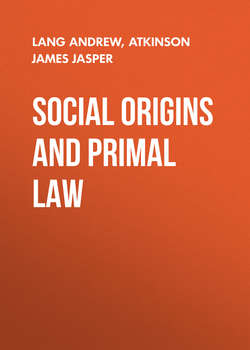Читать книгу Social Origins and Primal Law - Lang Andrew - Страница 13
CHAPTER II
THE CLASS SYSTEM
ОглавлениеUnder this name appear to be blended, (1) the prohibition to marry within a division, which, in its simplest form, is said to cut the tribe into two 'classes' or 'phratries,' or 'groups;'61 (2) the prohibition to marry within the totem name; (3) the prohibition to marry within the generation, and within certain recognised degrees ('classes,' 'sections') of real or inferred kinship – 'too near flesh,' too close consanguinity, which, in their present condition, many Australian tribes undoubtedly regard as a bar to matrimony. But it does not follow that they originally held this opinion.
We shall first examine what authorities who differ from me, call the great 'bisection' of the tribe, into, say, Matthurie and Kirarawa, members of which must intermarry, the totem prohibition also remaining in force. It will here be suggested, in accordance with what has already been said, but contrary to general opinion, that the totemic prohibition is earlier than the prohibition of marriage between persons of the same segment of the 'bisection.' The opinions of most students appear, at present, to be divided thus. We hear that:
1. The exogamous division into two moieties, or 'phratries,' is earlier than the division of each into numerous totem kins. The totem kins are regarded as later 'subdivisions' of, or additions to, the two 'original' moieties.
2. Totem groups are earlier than the 'bisection' (though somehow, according to the same authors, the two moieties of the bisection bore totem names), but, before the 'bisection,' these totem groups were not exogamous. They only became exogamous when six of them, say, were arranged in one of the two moieties (phratries), now forbidden to marry, and another six in the other.
I venture to prefer, as already indicated, the system (3) that totem groups not only existed, but were already exogamous, before the great 'bisection' producing the 'phratries' came into existence, though I argue that 'bisection' is a misleading term, and that the apparent division was really the result of an amalgamation of two separate and independent local totem groups.
This theory (presently to be more fully set forth) is original on my part, at least as far as my supraliminal consciousness is concerned. I mean that I conceived myself to have hit on the idea in July 1902. But something very like my notion (I later discovered) had been printed by Dr. Durkheim, and something not unlike it was propounded by Herr Cunow (1894). Mr. Daniel McLennan had also suggested it: and I find that the Rev. John Mathew had stated a form of it in his Eagle-Hawk and Crow (1899), (pp. 1922, 93-112). Mr. Mathew's hypothesis, however, involves a theory of contending and alien races in Australia. This theory does not seem well based, but, however that may be, I recognise that Mr. Mathew's hypothesis of the origin of exogamy (p. 98), and of the origin of the 'phratries' or 'primary classes,' in many respects anticipates my own. He opposes Mr. Howitt's conclusions, and I may be allowed to say that I would prefer Mr. Howitt, owing to his unrivalled knowledge, as an ally. On the other hand, the undesigned coincidence of Dr. Durkheim's, Mr. Daniel McLennan's, Mr. Mathew's, and Herr Cunow's ideas with my own, raises a presumption that mine may not be untenable.
61
Apparently, among the Kamilaroi, members of the same phratry may intermarry, avoiding unions in their own totems. Mathews (Proc. Roy. Soc. N.S.W. xxxi. 161, 162). Mr. Mathews calls a 'phratry' a 'group.'
